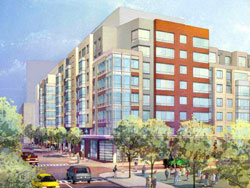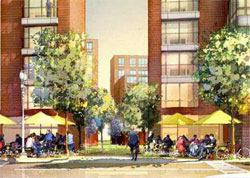
| Vol.
XIX No.
6 May / June 2007 |
| contents |
| Printable Version |
A New Cooperative Residence for the MIT Community
A Brief History
Since the end of WWII there have been a number of initiatives that have addressed the vexing problem of providing convenient, appropriate, and reasonably-priced housing for MIT's faculty and staff. In 1948 MIT's treasurer, Horace Ford, leased land on Memorial Drive to the New England Life Insurance Company for the purpose of building 100 Memorial Drive, an apartment house that has provided rental housing to both members of the faculty as well as the general public. In 1951, MIT economics professor W. Rupert McLaurin envisioned the development of affordable housing for young MIT and Harvard faculty and graduate students. He provided the initial funds to establish the now famous Conantum community in Concord, Mass. The buildings designed by Carl Koch, an MIT professor of architecture, provided 100 homes on 190 acres. At the time, Conantum advertised that the community was but 22 minutes from Harvard Square. In 1962, the desire for housing closer to the campus stimulated a proposal to build a faculty cooperative residence on land to be leased from MIT. This proposal was thought to be ahead of its time and was shelved. In the years that followed, other initiatives were taken by MIT to provide suitable housing for faculty in Cambridge, but for the most part they have not survived.
A New Faculty and Alumni Initiative
Beginning in the spring of 2003, a group of MIT and Harvard faculty and alumni met to consider the possibility of developing a residence to serve the university community in Cambridge. In January of 2004, nine members of the group organized as University Residential Communities, LLC (URC). In the fall of 2004, URC entered into an agreement with the Beal Companies, Boston-based developers with extensive experience in the Cambridge market, to assist URC in the development process. The URC founders designated several members as managers, who have contributed their time and talents in order to bring the project to this point. They include Paul Gray, Neil Harper, and O. Robert Simha of MIT, and Carl Sapers of Harvard. One of the founders, Bob Simha, has agreed to undertake substantial responsibilities as Executive Officer through the completion of the project.
Preliminary surveys and discussions led to the decision to locate the facility within walking distance of the MIT campus. A series of meetings with the MIT Medical Department, Athletic Department, Alumni Office, and other MIT agencies established an early openness of the MIT community to the presence of a nearby residential community of the kind envisioned. The MIT administration, while supportive of our effort, was, however, not in a position to participate financially in this enterprise.
The main idea behind the project was to create a multi-generational community of people with an affinity for university life and to locate the facility as near as possible to the campus.
The emphasis was on developing a facility that would appeal to people who shared an interest in the intellectual, cultural, and social life in the Boston/Cambridge area.
There was also a desire to design the facility with physical and programmatic features that would enable residents to age gracefully in place and to remain in their apartments for as long as they wished.
Consideration of the objectives outlined above eventually led to the decision to organize the residential community into a co-operative form of ownership, an ownership structure that will allow greater control over the nature of the community and greater flexibility in certain financing alternatives. Eligibility for membership in the cooperative will initially be open to faculty, staff, employees, graduates, and others with affiliations at MIT, Harvard, and the Massachusetts General Hospital.
For the past two years, the URC managers and the Beal Company have been exploring housing site opportunities within the MIT neighborhood and, in April of 2007, we signed an agreement with the Extell Corporation that will enable us to accomplish our objectives – in a new, eight-story cooperative residence now being constructed at 303 Third Street in Kendall Square Cambridge, just a short walk from the Kendall/MIT T station and the entrance to East Campus.
The site is composed of two buildings: the South Building, which will be the URC co-op containing 168 units, and the North Building, which will be a rental apartment building owned by the Equity Residential REIT of Chicago.
The new residence will have apartments varying in size from one to three bedrooms. Each unit will be fully equipped, and the residence will have 24-hour concierge service, common rooms, meeting rooms, a media room, a swimming pool, health and fitness facilities, a dining club, and parking in an underground garage. We expect that the MIT Medical Department will be available to all residents. In addition, access will be provided to the wide range of intellectual and cultural activities on the MIT campus.
The cost of apartments will range from $510,000 to $1,500,000. Sizes range from 750 square feet to over 2,000 square feet. The apartments are scheduled for occupancy in the fall and early winter of 2008.
Twenty-one of the units will be made available to the Cambridge Affordable Housing Program at very substantial discounts. These units will be available on a lottery basis to any person who meets the income guidelines established by the City. These guidelines include income levels which cover many members of the MIT community, and we would encourage all who qualify to apply.
We believe that the residence will offer the opportunity to live amongst both younger faculty and staff beginning their careers, and older members of the MIT community who wish to spend their working and retirement years in the stimulating environment that is MIT.
The goal of this new community is to provide an opportunity for MIT faculty, staff, and alumni to be part of a congenial living and teaching community that will provide a range of services and amenities, for all age groups. We believe the community will reflect one of MIT’s greatest strengths: the belief that we can continue to make contributions to learning by engaging in the life of the mind and doing those things that enriches our lives and the lives of others.
If you are interested in learning more about this residential opportunity please contact either of the authors of this article or visit the Website: web.mit.edu/ir/urc/update.html.
| Back to top | |
| Send your comments |
| home this issue archives editorial board contact us faculty website |

